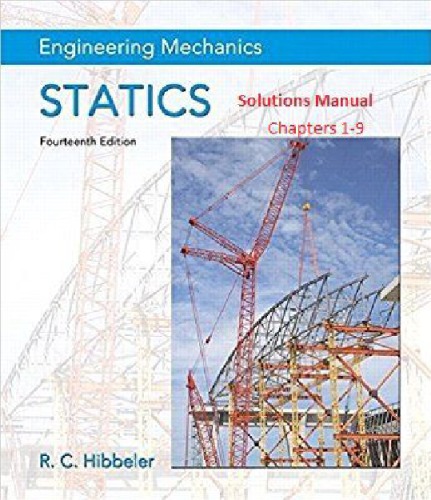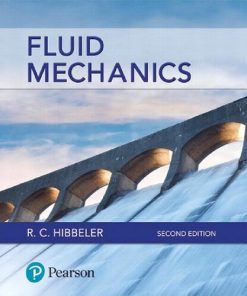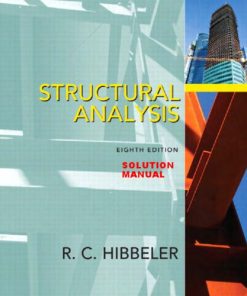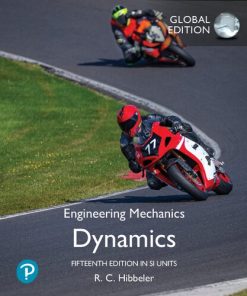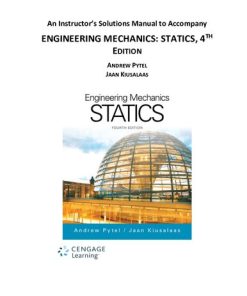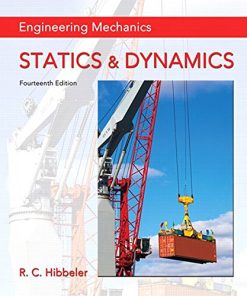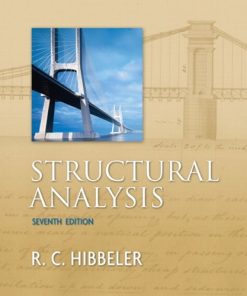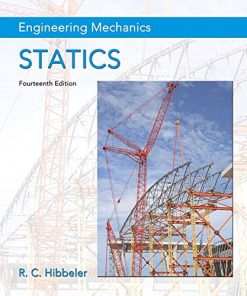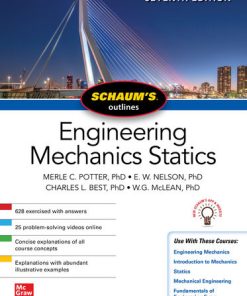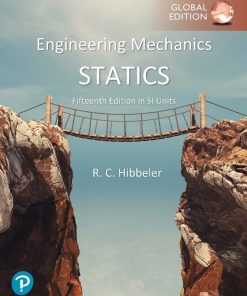(EBOOK PDF)Engineering Mechanics Statics Solutions Manual Chapters 1 9 14th Edition by Russell Hibbeler 9780133921656 0133921654 full chapters
$50.00 Original price was: $50.00.$25.00Current price is: $25.00.
Engineering Mechanics Statics Solutions Manual Chapters 1 9 14th Edition by Russell Hibbeler – Ebook PDF Instant Download/Delivery: 9780133921656, 0133921654
Full download Engineering Mechanics Statics Solutions Manual Chapters 1 9 14th Edition after payment
Product details:
• ISBN 10:0133921654
• ISBN 13:9780133921656
• Author:Russell Hibbeler
Engineering Mechanics: Statics
NOTE: You are purchasing a standalone product; MasteringEngineering does not come packaged with this content. If you would like to purchase both the physical text and MasteringEngineering search for0133918920 / 9780133918922 Engineering Mechanics: Statics plus MasteringEngineering with Pearson eText — Access Card Package, 14/e Package consists of: 0133915425 / 9780133915426 Engineering Mechanics: Statics 0133916375 / 9780133916379 MasteringEngineering with Pearson eText — Standalone Access Card — for Engineering Mechanics: Statics & Dynamics MasteringEngineering should only be purchased when required by an instructor. A Proven Approach to Conceptual Understanding and Problem-solving Skills Engineering Mechanics: Statics excels in providing a clear and thorough presentation of the theory and application of engineering mechanics. Engineering Mechanics empowers students to succeed by drawing upon Professor Hibbeler’s everyday classroom experience and his knowledge of how students learn. This text is shaped by the comments and suggestions of hundreds of reviewers in the teaching profession, as well as many of the author’s students. The Fourteenth Edition includes new Preliminary Problems, which are intended to help students develop conceptual understanding and build problem-solving skills. The text features a large variety of problems from a broad range of engineering disciplines, stressing practical, realistic situations encountered in professional practice, and having varying levels of difficulty. Also Available with MasteringEngineering — an online homework, tutorial, and assessment program designed to work with this text to engage students and improve results. Interactive, self-paced tutorials provide individualized coaching to help students stay on track. With a wide range of activities available, students can actively learn, understand, and retain even the most difficult concepts. The text and MasteringEngineering work together to guide students through engineering concepts with a multi-step approach to problems.
Engineering Mechanics Statics Solutions Manual Chapters 1 9 14th Table of contents:
Engineering Mechanics: Statics
Chapter 1 General Principles
Chapter Objectives
1.1 Mechanics
Historical Development
1.2 Fundamental Concepts
Basic Quantities
Length
Time
Mass
Force
Idealizations
Particle
Rigid Body
Concentrated Force
Newton’s Three Laws of Motion
First Law
Second Law
Third Law
Newton’s Law of Gravitational Attraction
Weight
1.3 Units of Measurement
SI Units
U.S. Customary
Conversion of Units
1.4 The International System of Units
Prefixes
Rules for Use
1.5 Numerical Calculations
Dimensional Homogeneity
Significant Figures
Rounding Off Numbers
Calculations
1.6 General Procedure for Analysis
Problems
Chapter 2 Force Vectors
Chapter Objectives
2.1 Scalars and Vectors
Scalar
Vector
2.2 Vector Operations
Multiplication and Division of a Vector by a Scalar
Vector Addition
Vector Subtraction
2.3 Vector Addition of Forces
Finding a Resultant Force
Finding the Components of a Force
Addition of Several Forces
Preliminary Problems
Fundamental Problems
Problems
2.4 Addition of a System of Coplanar Forces
Scalar Notation
Cartesian Vector Notation
Coplanar Force Resultants
Fundamental Problems
Problems
2.5 Cartesian Vectors
Right-Handed Coordinate System
Rectangular Components of a Vector
Cartesian Unit Vectors
Cartesian Vector Representation
Magnitude of a Cartesian Vector
Coordinate Direction Angles
Transverse and Azmuth Angles
2.6 Addition of Cartesian Vectors
Preliminary Problems
Fundamental Problems
Problems
2.7 Position Vectors
x, y, z Coordinates
Position Vector
2.8 Force Vector Directed Along a Line
Preliminary Problems
Fundamental Problems
Problems
2.9 Dot Product
Laws of Operation
Cartesian Vector Formulation
Applications
Preliminary Problems
Fundamental Problems
Problems
Chapter Review
Review Problems
Chapter 3 Equilibrium of a Particle
Chapter Objectives
3.1 Condition for the Equilibrium of a Particle
3.2 The Free-Body Diagram
Springs
Cables and Pulleys
Smooth Contact
3.3 Coplanar Force Systems
Preliminary Problems
Fundamental Problems
Problems
Conceptual Problems
3.4 Three-Dimensional Force Systems
Fundamental Problems
Problems
Chapter Review
Review Problems
Chapter 4 Force System Resultants
Chapter Objectives
4.1 Moment of a Force—Scalar Formulation
Magnitude
Direction
Resultant Moment
4.2 Cross Product
Magnitude
Direction
Laws of Operation
Cartesian Vector Formulation
4.3 Moment of a Force—Vector Formulation
Magnitude
Direction
Principle of Transmissibility
Cartesian Vector Formulation
Resultant Moment of a System of Forces
4.4 Principle of Moments
Preliminary Problems
Fundamental Problems
Problems
4.5 Moment of a Force about a Specified Axis
Scalar Analysis
Vector Analysis
Preliminary Problems
Fundamental Problems
Problems
4.6 Moment of a Couple
Scalar Formulation
Vector Formulation
Equivalent Couples
Resultant Couple Moment
Fundamental Problems
Problems
4.7 Simplification of a Force and Couple System
System of Forces and Couple Moments
Preliminary Problem
Fundamental Problems
Problems
4.8 Further Simplification of a Force and Couple System
Concurrent Force System
Coplanar Force System
Parallel Force System
Reduction to a Wrench
Preliminary Problems
Fundamental Problems
Problems
4.9 Reduction of a Simple Distributed Loading
Loading Along a Single Axis
Magnitude of Resultant Force
Location of Resultant Force
Fundamental Problems
Problems
Chapter Review
Review Problems
Chapter 5 Equilibrium of a Rigid Body
Chapter Objectives
5.1 Conditions for Rigid-Body Equilibrium
Equilibrium in Two Dimensions
5.2 Free-Body Diagrams
Support Reactions
Internal Forces
Weight and the Center of Gravity
Idealized Models
Problems
5.3 Equations of Equilibrium
Alternative Sets of Equilibrium Equations
5.4 Two- and Three-Force Members
Two-Force Members
Three-Force Members
Preliminary Problems
Fundamental Problems
Problems
Conceptual Problems
Equilibrium in Three Dimensions
5.5 Free-Body Diagrams
Support Reactions
Free-Body Diagrams
5.6 Equations of Equilibrium
Vector Equations of Equilibrium
Scalar Equations of Equilibrium
5.7 Constraints and Statical Determinacy
Redundant Constraints
Improper Constraints
Preliminary Problems
Fundamental Problems
Problems
Chapter Review
Review Problems
Chapter 6 Structural Analysis
Chapter Objectives
6.1 Simple Trusses
Assumptions for Design
Simple Truss
6.2 The Method of Joints
6.3 Zero-Force Members
Preliminary Problems
Fundamental Problems
Problems
6.4 The Method of Sections
Fundamental Problems
Problems
*6.5 Space Trusses
Assumptions for Design
Problems
6.6 Frames and Machines
Preliminary Problems
Fundamental Problems
Problems
Chapter Review
Review Problems
Chapter 7 Internal Forces
Chapter Objectives
7.1 Internal Loadings Developed in Structural Members
Sign Convention
Preliminary Problems
Fundamental Problems
Problems
*7.2 Shear and Moment Equations and Diagrams
Fundamental Problems
Problems
*7.3 Relations between Distributed Load, Shear, and Moment
Distributed Load
Relation between the Distributed Load and Shear
Relation between the Shear and Moment
Force
Couple Moment
Fundamental Problems
Problems
*7.4 Cables
Cable Subjected to Concentrated Loads
Cable Subjected to a Distributed Load
Cable Subjected to Its Own Weight
Problems
Chapter Review
Review Problems
Chapter 8 Friction
Chapter Objectives
8.1 Characteristics of Dry Friction
Theory of Dry Friction
Equilibrium
Impending Motion
Motion
Characteristics of Dry Friction
8.2 Problems Involving Dry Friction
Types of Friction Problems
No Apparent Impending Motion
Impending Motion at All Points of Contact
Impending Motion at Some Points of Contact
Equilibrium Versus Frictional Equations
Preliminary Problems
Fundamental Problems
Problems
Conceptual Problems
8.3 Wedges
8.4 Frictional Forces on Screws
Upward Impending Motion
Self-Locking Screw
Downward Impending Motion, θ>ϕs
Downward Impending Motion, ϕs>θ
Problems
8.5 Frictional Forces on Flat Belts
Frictional Analysis
Problems
*8.6 Frictional Forces on Collar Bearings, Pivot Bearings, and Disks
Frictional Analysis
8.7 Frictional Forces on Journal Bearings
Frictional Analysis
*8.8 Rolling Resistance
Problems
Chapter Review
Review Problems
Chapter 9 Center of Gravity and Centroid
Chapter Objectives
9.1 Center of Gravity, Center of Mass, and the Centroid of a Body
Center of Gravity
Center of Mass of a Body
Centroid of a Volume
Centroid of an Area
Centroid of a Line
Preliminary Problem
Fundamental Problems
Problems
9.2 Composite Bodies
Fundamental Problems
Problems
*9.3 Theorems of Pappus and Guldinus
Surface Area
Volume
Composite Shapes
Fundamental Problems
Problems
*9.4 Resultant of a General Distributed Loading
Magnitude of Resultant Force
Location of Resultant Force
*9.5 Fluid Pressure
Flat Plate of Constant Width
Curved Plate of Constant Width
Flat Plate of Variable Width
Fundamental Problems
Problems
Chapter Review
Review Problems
Chapter 10 Moments of Inertia
Chapter Objectives
10.1 Definition of Moments of Inertia for Areas
Moment of Inertia
10.2 Parallel-Axis Theorem for an Area
10.3 Radius of Gyration of an Area
Fundamental Problems
Problems
10.4 Moments of Inertia for Composite Areas
Fundamental Problems
Problems
*10.5 Product of Inertia for an Area
Parallel-Axis Theorem
*10.6 Moments of Inertia for an Area about Inclined Axes
Principal Moments of Inertia
*10.7 Mohr’s Circle for Moments of Inertia
Problems
10.8 Mass Moment of Inertia
Parallel-Axis Theorem
Radius of Gyration
Composite Bodies
Problems
Chapter Review
Review Problems
Chapter 11 Virtual Work
Chapter Objectives
11.1 Definition of Work
Work of a Force
Work of a Couple Moment
Virtual Work
11.2 Principle of Virtual Work
11.3 Principle of Virtual Work for a System of Connected Rigid Bodies
Fundamental Problems
Problems
*11.4 Conservative Forces
Weight
Spring Force
Friction
*11.5 Potential Energy
Gravitational Potential Energy
Elastic Potential Energy
Potential Function
*11.6 Potential-Energy Criterion for Equilibrium
*11.7 Stability of Equilibrium Configuration
Stable Equilibrium
Neutral Equilibrium
Unstable Equilibrium
One-Degree-of-Freedom System
Problems
Chapter Review
Review Problems
Appendix A Mathematical Review and Expressions
Fundamental Problems Partial Solutions And Answers
Chapter 2
Chapter 3
Chapter 4
Chapter 5
Chapter 6
Chapter 7
Chapter 8
Chapter 9
Chapter 10
Chapter 11
Preliminary Problems Statics Solutions
Chapter 2
Chapter 3
Chapter 4
Chapter 5
Chapter 6
Chapter 7
Chapter 8
Chapter 9
Review Problem Solutions
Chapter 2
Chapter 3
Chapter 4
Chapter 5
Chapter 6
Chapter 7
Chapter 8
Chapter 9
Chapter 10
Chapter 11
Answers to Selected Problems
Chapter 1
Chapter 2
Chapter 3
Chapter 4
Chapter 5
Chapter 6
Chapter 7
Chapter 8
Chapter 9
Chapter 10
Chapter 11
Index
People also search for Engineering Mechanics Statics Solutions Manual Chapters 1 9 14th:
engineering mechanics: statics
engineering mechanics statics
engineering mechanics statics 14th edition
meriam’s engineering mechanics statics
engineering mechanics statics pdf
Tags:
Engineering Mechanics,Solutions Manual,Russell Hibbeler
You may also like…
Physics - Mechanics: Fluid Mechanics
Fluid Mechanics 2nd Edition by Russell Hibbeler 0134626055 9780134626055
Engineering - Mechanical Engineering & Dynamics
Engineering Mechanics: Dynamics, SI Units 15th Edition Russell Hibbeler
Engineering - Mechanical Engineering & Dynamics
Engineering Mechanics: statics, Instructor’s Solutions Manual 4th Edition Andrew Pytel
Engineering
Uncategorized
Engineering - Mechanical Engineering & Dynamics


